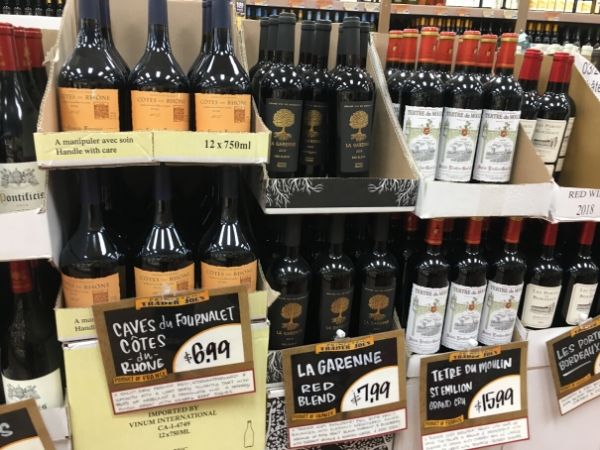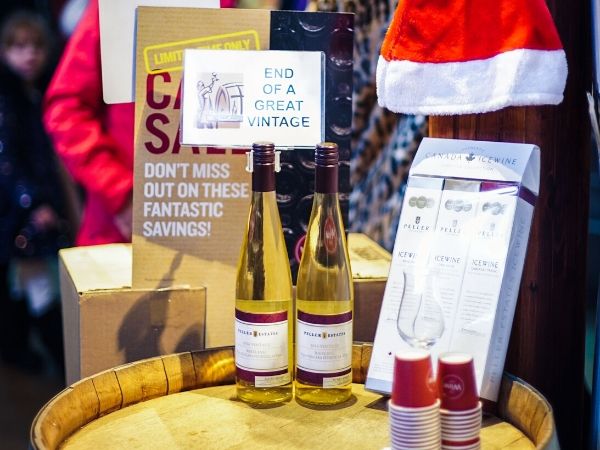Super Early Bird Deadline
October 31, 2025
Judging
Date
May 18, 2026
Winners
Announced
June 10, 2026

Understanding how chain stores source new wine, beer and spirits means taking the time to research each chain respectively and perfecting your pitch to fit the buyer's profile. Ratings, reviews, price, margin, supply, merchandising - these are all key aspects of a well developed brand ready for national distribution.
Even after you've targeted your key partners and done your due diligence it can take a very long time to secure a meeting with a chain store buyer and getting them to focus on your brand is difficult.
From developing your local distribution network to working with category managers inside the offices of large retailers, each new relationship you develop is an important aspect of successful expansion.
SCA interviews Adam Vignola, Former Sales and Operations at Total Wine, on how to pitch your liquor, beer and wine to a national chain.
Adam: My first point would be: Does it have a local tie in?
Chain retailers generally do localized sets in the US. If the wine brand has a local connection, start by showcasing the highlights of your local markets. If you've done a good job at establishing your brand, then it should be easy to leverage the built in customer base as a strong selling point. For example, a Whole Foods in Marin County (north of SF) would look at a Marin County Wine or a Sonoma County as more desirable to than a wine from Temecula.
Focusing on a local store specific set is a good way to establish your relationship with the buyer. Expand your way across the chain after you build your reputation as a dependable supplier to local accounts.

If you are representing an international brand that doesn't have a local tie in, focus on the specific requirements that the chain is known to ask for when sourcing a new wine, beer or spirit.
For Costco you should be ready to present a good portfolio of ratings. Make it a priority to pitch your brand to nationally renowned reviews and competitions and.
In the case of Whole Foods, it would be a “sustainable” tie in – either a SIP certificate (Sustainable in Practice), an organic designation or Biodynamic designation. No matter the chain, they are always looking for a specific 'fit' for their stores, so make it your priority to do understand the needs of each Chain you pitch.
If you still have time at your meeting, talk about the lack of this “type of wine.” I’ve noticed from doing store wine set surveys for Costco and Whole Foods that they are always looking for a unique offering that will service a trend. For example, you should underline the strength of your timing by saying something like, “I didn’t see any Provence Rose’s in your set and we’re moving into warm weather – perfect Rose wine season,” or, “This is a great Seasonal Wheat Beer. It’s getting warmer and Witbier has seen double digit growth in the US over the last 52 weeks.”
Adam: Buyers respond well to:
1. Competitive price, Ratings and Reviews;
2. Exclusive Offering;
3. Your lowest price being available for any size of order;
4. Solid IRI data - top 25 national off premise SKU that has seen double digit growth over the last 52 weeks in the Nielsen’s IRI data;
5. 40% Margin through incentive programs. This margin may come from either a temporary invoice price reduction (TPR), or through an IRC (Instant rebate coupon given at check out) or a CQD (cumulative case discount). For example, you can say, “If you buy 300 cases in a 90 day period I will give you back $12 a case on all 300 cases which effectively makes margin of profit closer to 40%.”
Adam: It is vital for the test stores to do well - I’ve even heard of instances where the vendor will purchase their own product to make the numbers look better. I wouldn’t recommend this approach, but it should be any brand’s priority to get their product moving at a steady rate in their stores. Once you get the test stores showing your SKU is resonating with the customers, then you are likely to get more locations. Usually, you have your placement in a set of category stores known to have a consumer base for your product.
Costco will sometimes give your product a certain amount of weeks to get into the “consciousness” of the consumer before passing final judgment. Even a Cost-Plus World Market or Safeway can show patience. If your wine doesn’t move in the most consumer savvy locations for the retailer, it may still fit a niche like a Brunello di Montalcino, flavored Vodka or novelty craft label and therefore won’t be discontinued. However, if you can't prove to them that your brand is a consistent performer you are likely to never see any more locations.
Adam: Merchandisers can be huge in the chains. Some chain stores demand them like WinCo and even BevMo. In the larger chains like Albertson’s, Safeway or Ralph’s they are important, but also a huge expense for the distributor. One of the principal reasons why big chains deal with big distributors is because big distributors have the deep pockets to pay for merchandisers. Smart distributors understand that once a buyer sees you are committed to servicing their stores, they will often give you more placements. In the same breath, a distributor like Southern or Young’s needs lots of placements in the Supermarket chains to make their merchandiser crew profitable.

If you have two or three placements in a chain and they are asking for you to come in and merchandise their department, it can be difficult to balance when figuring in pay and employee benefits. This is truly where a small distributor must take the time and perhaps take a momentary profit loss to consider the big picture.
Sometimes, if you are the account executive for your small distributor with the Chain, you will also become the de facto merchandiser as well. In the end, if you want more placements with the chain in the future then you will merchandise your brands and show the Chain wine buyer you’re committed to his or hers company’s success.
Adam: This is the first question thus far that implies out of state chain distribution for a national brand. Most national chains (Kroger, Whole Foods, Costco, Safeway, Supervalu etc., etc.) have regional buyers who are concerned with their regional network of stores. So, the Ralph’s buyer (Kroger banner) may deal with a small brand in CA for his or her stores and their only concern is the distributor network for Northern and Southern California that will deliver the brand to their Ralph’s store locations or to the central warehouse for Ralph’s.
This would be the thought process too of the Safeway CA buyer in Pleasanton whose only concern is the network in California. The Safeway regional buyer in Seattle’s network of concern is the Oregon and Washington distributor network for the brand. When a brand is a control label for a Supermarket Chain the chain buyer may assist in helping you secure distributor placements nationally to distribute the brand to all chain locations.
But let’s take your question at face value. Let’s say you want to launch a hundred thousand case Moscato wine brand tomorrow. First, what you would need to establish with a Chain is demand. Moscato’s are red hot in the Nielsen IRI data. Done. Then you would need to have a meeting with a chain buyer and ask for an authorization for the Moscato brand. The demand that Moscato’s are currently seeing would make most buyers interested in hearing about the brand, if not taking a chance on the wine SKU.
Then you would simply have to tell the distributor in Missouri that the Dollar Tree wine buyer is interested in the brand for his stores inside the state. A simple “new item form” with the chain that includes the Moscato on it would be all the verification the distributor would need to order in product. I’ve done this type of distributor authorization to bring product in based on my word that the Chain wine buyer wanted to bring the brand into his or hers store wine sets.
Now, let’s make it a little harder. Consider the scenario that you’re thinking of launching an imported beer brand with three labels that will all retail for $6.99. You are going to be one of the leaders at that price point in the craft category. However, your business plan needs you to be selling full containers at a time to make the profit model work.
The best way to achieve this is to simply get one retailer to agree to bring your brand in. At that point you are only dealing with certain states that the Grocery store chain operates in and that allow beer sales in grocery stores.
Want to Pitch Your Wine To Mr. Retailer? Here's an effective way
Once you’ve established success for the brand in one chain you then look to partner with another distributor network – meaning wherever the distributor is operating the imported beer brand is in their house. Get the chain account executives to make the brand a focus in Supermarket chains…and then you cross your fingers. This would be the W. J. Deutsch approach taken a couple years ago with Yellow Tail.
One last way to get a brand to catch national fire is to have an in house category managers from somebody like Gallo or Southern Wine & Spirits sit inside the offices of a retailer like Food Lion, Target, Walgreens or a Safeway. These are employees working for a winery or distributor that assists in data analysis (we call it SKU rationalization) and planogram managements for a Chain.
Basically, this individual working for another entity but occupying a cubicle inside the chain will assist in setting, resetting, and rotating the brands sold and offered for sale in this chain. Effectively, they help their own products and the products of competitors get selected, placed and promoted inside the chain. It’s quasi legal….or so I’m told. In my opinion, with that kind of access to a decision maker (the wine buyers) and that level of daily interaction (working in the same building as vendors and the retailer), it’s possible to get a brand to go national in a very small turnaround time.
Image credit: Flickr
 Sommeliers Choice Awards gathers the top wine restaurant buyers, Master Sommeliers, wine directors who have a direct influence on the US on-premise market.
Sommeliers Choice Awards gathers the top wine restaurant buyers, Master Sommeliers, wine directors who have a direct influence on the US on-premise market.
Put your wines in front of them and get rated by Food Parability, Typicity, Value, Quality, and Package.
If you're looking to get in front of the top sommeliers and on-premise wine buyers of the USA, now is the best time to enter your wines. Save up to $50 per wine.
Leading wine brands from around the world now have an opportunity to grow their business and gain the attention of wine buyers, wine directors and influencers within the U.S. on-premise industry. Time to submit your wines in the 2020 Sommeliers Choice Awards.
Enter your Wines now and get in front of top Sommeliers, Wine Directors, and On-Premise Wine Buyers of USA.
